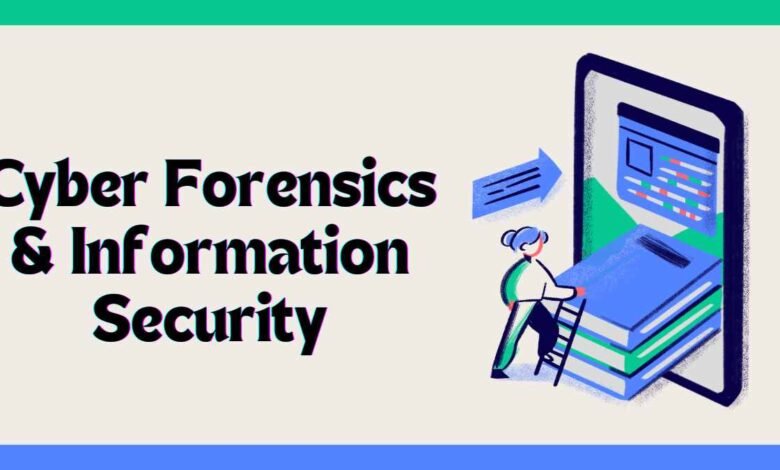Cyber Forensics & Information Security: How to Investigate

Cyber forensics & information security the rapid evolution of technology has given rise to new challenges in securing sensitive information.The importance of these fields has never been greater as individuals, organizations, and governments face mounting cyber threats daily.
What is Cyber Forensics?
Cyber forensics, also known as digital forensics, refers to the process of identifying, preserving, analyzing, and presenting digital evidence in a manner admissible in court. The objective is to uncover hidden or deleted data that might point to criminal activities. Whether it’s hacking, fraud, or unauthorized data access, cyber forensics experts are the first responders in investigating these incidents.
The Role of Digital Forensics Investigations
Digital forensics investigations are essential for gathering digital evidence from devices such as computers, smartphones, servers, and even cloud environments. Investigators use specialized tools to sift through vast amounts of data to retrieve, recover, and analyze information.
Computer Forensics Analysis
Computer forensics is a branch of digital forensics that primarily focuses on investigating computers and storage devices. The analysis in this field includes examining file systems, retrieving deleted files, and uncovering hidden or encrypted data that may indicate criminal actions.
Must Visit: Twist Tale
Cybercrime Investigation Techniques

As cybercrime becomes more sophisticated, so do the investigation techniques used to combat it. Cyber forensics professionals need a thorough understanding of the following techniques:
Network Forensics
This technique involves monitoring and analyzing network traffic in real time to detect and prevent malicious activities. Network forensics helps in identifying unusual traffic patterns, unauthorized access attempts, and the flow of sensitive data, which may indicate a breach.
Malware Analysis
Malware analysis is crucial in understanding how malware operates and how it infiltrates systems. Investigators examine malware’s code to trace its origin and determine the potential damage it can cause. By dissecting malware, investigators gain insights into its behavior, allowing for better defense strategies.
Incident Response
Incident response teams are tasked with managing cyber incidents when they occur. Quick response to a breach or cyber attack is critical in limiting the damage. This includes isolating affected systems, recovering data, and ensuring the threat is neutralized.
Social Engineering Analysis
One of the most effective ways cybercriminals infiltrate systems is through social engineering. Investigators analyze social engineering techniques used, such as phishing, to understand how attackers manipulate victims into providing sensitive information or access to systems.
Information Security Management
While cyber forensics focuses on post-incident investigations, information security management plays a preventative role. Information security encompasses the policies, procedures, and practices put in place to protect data from unauthorized access, alteration, or destruction.
What is Information Security?
Information security, often referred to as InfoSec, focuses on protecting the integrity, confidentiality, and availability of information from unauthorized access, use, disclosure, disruption, or destruction. Information security encompasses a wide range of practices and technologies designed to protect data in both physical and digital forms.
Key Components of Information Security
Confidentiality
The principle of confidentiality ensures that sensitive data is accessible only to those authorized to view it. Organizations employ encryption, access controls, and authentication protocols to uphold this principle.
Integrity
Information security management ensures that data is protected from unauthorized modifications that could compromise its reliability.
Availability
Availability ensures that data is readily accessible to authorized users when needed. Information security management focuses on protecting systems and data from disruptions. It ensures continuous operations, even in the presence of cyber threat
Information Security in Preventing Cybercrime
Information security management goes hand in hand with cyber forensics. While forensics deals with investigating breaches after they happen, information security management focuses on preventing these incidents. A well-rounded information security program includes robust firewalls, intrusion detection systems, antivirus software, and employee training to recognize potential threats.
Data Breach Response

When a data breach occurs, quick and efficient response is critical to minimize the damage. A data breach response plan is a strategic framework that outlines the steps an organization should take immediately following a breach. Cyber forensics plays a vital role during this phase as investigators work to determine how the breach occurred and gather evidence for legal proceedings if needed.
Cyber Forensics and Information Security in the Modern World
With the growing dependence on digital technologies,have become indispensable in protecting sensitive data and ensuring the integrity of systems. Businesses, governments, and individuals must stay vigilant against evolving threats, and cybersecurity experts must continuously update their skills to stay ahead of cybercriminals. The interplay between and is what creates a comprehensive cybersecurity strategy.
Conclusion
In an increasingly interconnected world, form the backbone of digital safety. From investigating cybercrimes to preventing data breaches, these fields are essential in protecting sensitive information and keeping cyber threats at bay. As cybercriminals continue to evolve their methods, so must our strategies in digital forensics and cybersecurity. The stakes are high, but with the right tools, techniques, and policies, organizations can ensure that they stay one step ahead of those who seek to do harm.
FAQs
What is the difference between cyber forensics and information security?
Focuses on investigating and collecting evidence from digital devices post-breach, while aims to prevent breaches by implementing protective measures.
How is data recovered during a cyber forensics investigation?
Data is recovered using specialized software tools that allow investigators to retrieve deleted, encrypted, or hidden information from digital devices.
Why is information security important?
Information security protects sensitive data from unauthorized access, ensuring that the confidentiality, integrity, and availability of the data are maintained.
What is malware analysis, and why is it essential?
Malware analysis involves examining the behavior and code of malware to understand its impact, trace its origin, and develop defense strategies to protect systems.
How does incident response work in the context of a cyber attack?
Incident response involves immediate actions to contain, eradicate, and recover from a cyber attack, minimizing damage and restoring systems to full functionality.
Read More: Network Marketing Ideas




